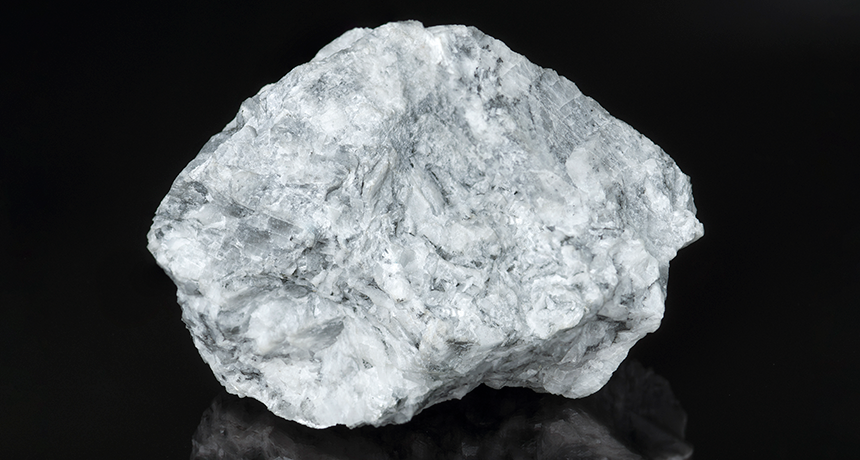Scientists find an easier way to trap carbon dioxide in rock
If they can scale it up, this process could someday help curb climate change

In nature, this magnesite takes thousands of years to form. Now researchers can make tiny amounts of this mineral in the lab. And it only takes three months to form.
A_Pobedimskiy/iStockphoto
Scientists have suggested trapping carbon dioxide in rocks as one way to slow the rate of climate change. But they hadn’t come up with an easy way to do it. All their proposed tactics appeared to be difficult, costly or require too much energy. Until now, anyway. Researchers in Canada have just proposed a new technology to collect and trap the greenhouse gas.
Limestone and other minerals already store a lot of carbon dioxide (CO2) on Earth, notes Ian Power. He’s a geoscientist at Trent University in Peterborough, Canada. The problem: This natural process is slow. It can take thousands or even millions of years. At present, he explains, “We’re emitting so much CO2 now that Earth can’t keep up.”
But Power’s team has just reported a way to quickly do what nature does slowly. A mineral called magnesite (MAG-nuh-syte) locks up CO2. A metric ton of this mineral (also known as magnesium carbonate) can store about half a metric ton of CO2. The chemical normally takes thousands of years to form. But in their lab, Power’s group made it happen in just a few months.
On August 14, Power described how his team did this at the Goldschmidt geochemistry conference in Boston, Mass.
How the lab cooked up this CO2 ‘sponge’ so quickly
Ions are electrically charged atoms or molecules. Power’s group combined positively charged magnesium ions and negatively charged carbonate ions. (Carbonate ions form when carbon dioxide mixes with water.) Magnesite naturally can hold a lot of CO2.
Magnesite occurs naturally. But the process by which it forms on Earth’s surface is very, very slow. Researchers had thought about pumping CO2 deep inside the Earth. How deep? Kilometers (miles) down into the mantle. There, rocks called olivine contain magnesium. It’s also quite hot there. Gases would get squished under high pressure, allowing magnesite to form faster there. But this process would be quite difficult and costly. Scientists first would have to find transport and store the CO2 that they hoped to trap in the rock. They’d also have to identify good places underground for inserting the CO2.
Power’s group opted to do it differently — in their lab.
To learn what they’d need to do, Power and his team investigated how Mother Nature makes magnesite. And to do that, they went to one place where they knew this mineral forms near Earth’s surface. It was a northern site in Canada’s western province of British Columbia.
At dry basins there known as playas (PLY-uhs), groundwater flows through rocks. Along the way, it picks up magnesium and carbonate ions. Over time, those ions react to make magnesite. The mineral slowly settles out of the water, creating rock.
“We knew it was slow,” Power says of the natural process. “But no one had ever measured the rate.” In British Columbia, the process began as far back as 11,000 years ago, he notes.
Scientists can combine rocks and CO2 using lots of heat in the lab. That could make the mineral quickly — but only by using a lot of costly energy, Power says. And that’s because water gets in the way. When magnesium ions are in water, the water molecules form a “shell” around the ions. This keeps the magnesium from bonding to carbonate ions. “It’s difficult to strip away those water molecules,” Power says. But unless you do, he adds, the magnesite will take a very long time to form.
To get around the problem, the researchers stripped water from the magnesium. To do this, they added thousands of little plastic balls, or microspheres. Each was about 20 micrometers (8 ten-thousandths of an inch) in diameter. Made out of polystyrene (Paal-ee-STY-reen), the tiny balls were coated with molecules that attract the water. As they tied up the water, the leftover magnesium ions now were free to bond with the carbonate.
Using the microballs, the researchers produced magnesite in 72 days, Power says. And the good news: The same microspheres could also be reused over and over, he says.
Still a long way to go
So far, the scientists have made only a tiny amount of magnesite in the lab. Their total — one microgram — is about one millionth the weight of a paper clip. So the process needs a lot of improvement before it can begin trapping the millions of tons of CO2 produced each year, Powers says.
But a big concern has been hurdled, he says. They’ve shown it is possible to do this at room temperature and pressure. Now the team can explore how to make the process more efficient.
“The result really surprised me,” says Patricia Dove. She is a geochemist at Virginia Tech in Blacksburg. It’s not clear how costly or efficient this process might be, she says. But she finds it “certainly very intriguing.”







